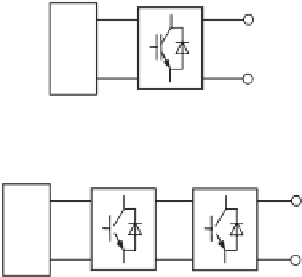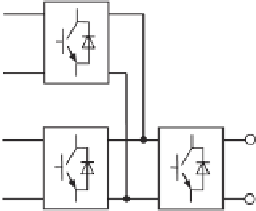Environmental Engineering Reference
In-Depth Information
rooftop installations are close to the consumption of electricity and they, therefore, reduce the
power transport through both the transmission and the distribution networks.
1.5.2 Processing of Solar Power
Similar to wind power, the source of solar power is not controllable and hence there is a need
to maximise the power generated from the sunlight. This can be done with MPPT strategies
implemented at an appropriate stage of power processing.
PV systems can be categorised according to the number of power processing stages, the
location of power decoupling capacitors, with or without transformers, and types of grid
interfaces etc (Carrasco
et al
. 2006b; Kjaer
et al
. 2005; Li and Wolfs 2008). Some typical
topologies for PV systems are shown in Figure 1.45. Power electronic inverters are essential
for converting the DC power produced by PV cells into AC power that is compatible with
the electricity distribution network and the majority of common electrical appliances. For a
grid-connected PV system, the inverter often plays two major roles: (1) to ensure that the PV
system captures the maximum power from the sunlight with a maximum-power-point-tracking
(MPPT) algorithm; and (2) to feed the energy into the grid, nowadays often as a clean current,
PPV
Grid
DC-AC
(a) Single-stage processing
PV
Grid
DC-AC
DC-DC
(b) Two-stage processing
PV
DC-DC
Grid
PV
DC-DC
DC-AC
(c) Two-stage processing with a shared DC bus
Figure 1.45
Some typical topologies for PV systems






Search WWH ::

Custom Search